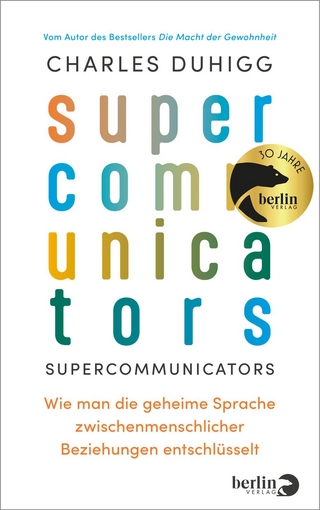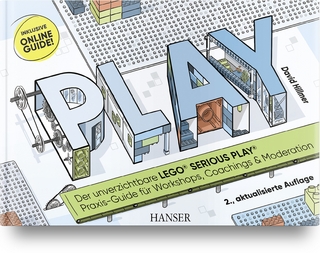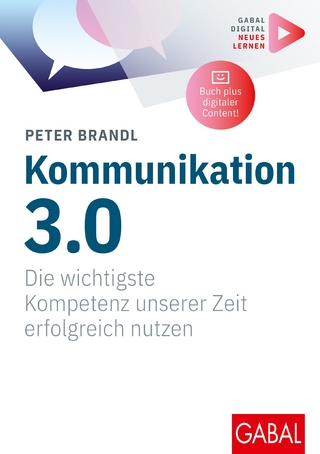
The Public Speaking Playbook
SAGE Publications Inc (Verlag)
978-1-5443-3240-6 (ISBN)
- Titel ist leider vergriffen;
keine Neuauflage - Artikel merken
Teri Kwal Gamble enjoyed a career as a full professor of communication at the College of New Rochelle in New Rochelle, NY (PhD, New York University; MA and BA, Lehman College, CUNY), and Michael W. Gamble, is a full professor of communication at the New York Institute of Technology in New York City (PhD, New York University; BA and MFA, University of Oklahoma). The Gambles are partners in life and work. Professional writers of education and training materials, the Gambles are the coauthors of numerous textbooks and trade books. Their most recent publication is The Interpersonal Communication Playbook (2020). Teri and Mike also are the coauthors of The Communication Playbook (2019). Among other books the Gambles have written together are Nonverbal Messages Tell More: A Practical Guide to Nonverbal Communication (2017), Leading with Communication (2013), and The Gender Communication Connection (2nd ed., 2014). Previously, Michael served as an officer and taught Leadership Skills for the U.S. Army Infantry School during the Vietnam War. The Gambles also are the founders of Interact Training Systems, a consulting firm that conducts seminars, workshops, and short courses for business and professional organizations. Teri and Mike also produce training and marketing materials for sales organizations and are the coauthors of the trade book, Sales Scripts That Sell. Teri Kwal Gamble enjoyed a career as a full professor of communication at the College of New Rochelle in New Rochelle, NY (PhD, New York University; MA and BA, Lehman College, CUNY), and Michael W. Gamble, is a full professor of communication at the New York Institute of Technology in New York City (PhD, New York University; BA and MFA, University of Oklahoma). The Gambles are partners in life and work. Professional writers of education and training materials, the Gambles are the coauthors of numerous textbooks and trade books. Their most recent publication is The Interpersonal Communication Playbook (2020). Teri and Mike also are the coauthors of The Communication Playbook (2019). Among other books the Gambles have written together are Nonverbal Messages Tell More: A Practical Guide to Nonverbal Communication (2017), Leading with Communication (2013), and The Gender Communication Connection (2nd ed., 2014). Previously, Michael served as an officer and taught Leadership Skills for the U.S. Army Infantry School during the Vietnam War. The Gambles also are the founders of Interact Training Systems, a consulting firm that conducts seminars, workshops, and short courses for business and professional organizations. Teri and Mike also produce training and marketing materials for sales organizations and are the coauthors of the trade book, Sales Scripts That Sell.
Preface
Acknowledgments
About the Authors
I. GET READY TO SPEAK
1. Building Confidence and Your First Speech
Section 1.1 Identify Speechmaking’s Benefits
Section 1.2 Discuss the Context of Public Speaking
Section 1.3 Assess and Build Your Speechmaking Confidence
Section 1.4 Approach Giving a Speech Systematically
2. Public Speaking in a Global World: Inclusion, Ethics, and Critical Thinking
Section 2.1 Respect Different Cultures
Section 2.2 Speak Ethically
Section 2.3 Think Critically
II. LISTEN AND LOOK
3. Listening Critically
Section 3.1 The Six Stages of Listening
Section 3.2 Listening and Cultural Differences
Section 3.3 The Benefits of Critical Listening
Section 3.4 The Four Types of Listening
Section 3.5 Listening Styles
Section 3.6 Improving Listening Behaviors
4. Analyzing and Adapting to the Audience
Section 4.1 Reach Out to Your Audience
Section 4.2 Answer Preliminary Questions
Section 4.3 Compose a Demographic Snapshot
Section 4.4 Compose a Psychographic Snapshot
Section 4.5 Consider the Speaking Situation
Section 4.6 Get Information About Your Audience
III. TOPIC AND RESEARCH
5. Selecting a Topic and Purpose
Section 5.1 Formulate a Topic
Section 5.2 Formulate General and Specific Purposes
Section 5.3 Formulate the Thesis Statement or Central Idea
6. Finding and Evaluating Research
Section 6.1 Use Primary Research
Section 6.2 Gather Secondary Research
Section 6.3 Why to Critically Assess Research
Section 6.4 Keep a Research Record
7. Integrating Support
Section 7.1 Use Examples
Section 7.2 Use Explanations and Descriptions
Section 7.3 Use Definitions
Section 7.4 Use Analogies
Section 7.5 Use Statistics
Section 7.6 Use Testimony
Section 7.7 Citing Sources in Your Speech
IV. ORGANIZE AND OUTLINE
8. Organizing the Main Points of Your Speech
Section 8.1 Understand Speech Patterns: Organization
Section 8.2 Use Linear Organizational Formats to Arrange a Speech’s Main Points
Section 8.3 Use Less Direct Configural Formats
9. Outlining Your Speech
Section 9.1 Create an Outline That Works for You
Section 9.2 Facilitate Speech Flow
Section 9.3 Practice Speaking with Your Outline
V. PRESENT YOUR SPEECH
10. Beginning and Ending Your Speech
Section 10.1 Capture Attention
Section 10.2 Build Credibility
Section 10.3 Preview the Big Ideas
Section 10.4 End Strong
Section 10.5 Avoid Common Pitfalls
11. Wording the Speech
Section 11.1 Understand How Words Work
Section 11.2 Use Words to Connect
Section 11.3 Consider Your Audience
Section 11.4 Be Strategic
Section 11.5 Use Oral Style
12. Delivery Modes and Practice
Section 12.1 Choose a Delivery Mode
Section 12.2 Prepare and Practice
Section 12.3 Avoid Common Delivery Bloopers
13. Delivering Your Speech: Nonverbal Messages Matter
Section 13.1 Nonverbal Messages: Beyond the Speaker’s Words
Section 13.2 Take Control of How You Sound
Section 13.3 Properly Use Pitch, Volume, Rate, Articulation, and Pronunciation
Section 13.4 Be Aware of Accents, Dialects, and Regionalisms
Section 13.5 Make the Most of the Setting
Section 13.6 Coordinate Your Body Language and Spoken Words
14. Using Presentation Aids
Section 14.1 Use Presentation Aids Strategically
Section 14.2 The Right and Wrong Ways to Work with Presentation Aids
Section 14.3 Select the Best Aids
Section 14.4 Be Familiar with Presentation Software
Section 14.5 Get the Most from Your Presentation Aids
VI. SPEAK TO INFORM
15. Speak to Inform
Section 15.1 Speeches About Objects and Ideas or Theories
Section 15.2 Speeches About Events and People
Section 15.3 Speeches About Processes, Procedures, and Demonstrations
Section 15.4 Achieving Informative Speaking Goals
VII. SPEAK TO PERSUADE
16. Prepare to Persuade
Section 16.1 We All Practice Persuasion
Section 16.2 Goals and Purposes of Persuasive Speech
Section 16.3 Categorize Propositions and Use Different Persuasive Approaches to Organize the Persuasive Speech.
Section 16.4 Understand and Use Monroe’s Motivated Sequence
17. Methods of Persuasion
Section 17.1 Varying Viewpoints and Your Target Audience
Section 17.2 Build Ethos or Persuasive Credibility
Section 17.3 Use Logos or Sound Evidence and Reasoning
Section 17.4 Arouse Pathos or Emotion
Section 17.5 Use Three Tenets of Persuasion
Section 17.6 Practice Ethical Persuasion: Avoid Fallacies and Slip-ups
VIII. SPECIALIZED SPEAKING CONTEXTS
18. Planning and Presenting in Small Groups
Section 18.1 Groups at Work
Section 18.2 Solving Problems Together
Section18.3 Presenting the Group’s Work
Section 18.4 Assessing the Group’s Performance
19. Special Occasion Speeches
Section 19.1 Goals and Functions of Special Occasion Speeches
Section 19.2 Types of Ceremonial Speeches
Section 19.3 The Speech of Introduction
Section 19.4 The Speech of Presentation
Section 19.5 The Speech of Acceptance
Section 19.6 The Commencement Address
Section 19.7 The Keynote Address
Section 19.8 The Toast
Section 19.9 The Speech of Tribute
Section 19.10 The Eulogy
Section 19.11 The After-Dinner Speech
20. Business and Professional Speaking
Section 20.1 First, Get the Job: How to Handle a Job Interview
Section 20.2 Speaking in a Meeting
Section 20.3 Pitching an Idea
Section 20.4 Delivering a Briefing or Report
Section 20.5 Conducting a Training Session
21. Storytelling
Section 21.1 Discover Your Inner Storyteller
Section 21.2 Use Language to Connect
22. Speaking Across College Courses
Section 22.1 Presenting Across College Courses
Section 22.2 Educational Contexts for Speaking Assignments
23. Presenting Online
Section 23.1 The Technological Difference
Section 23.2 Formats for Online Presentations
Section 23.3 Online Presentation Platforms: Screens and Sound
24. Answering Questions
Section 24.1 The Timing of the Q&A Session
Section 24.2 Managing the Q&A
Glossary
Notes
Index
| Erscheinungsdatum | 24.01.2020 |
|---|---|
| Verlagsort | Thousand Oaks |
| Sprache | englisch |
| Maße | 187 x 231 mm |
| Gewicht | 850 g |
| Themenwelt | Sachbuch/Ratgeber ► Beruf / Finanzen / Recht / Wirtschaft ► Briefe / Präsentation / Rhetorik |
| Geisteswissenschaften ► Sprach- / Literaturwissenschaft ► Literaturwissenschaft | |
| Sozialwissenschaften ► Kommunikation / Medien ► Allgemeines / Lexika | |
| Sozialwissenschaften ► Kommunikation / Medien ► Kommunikationswissenschaft | |
| ISBN-10 | 1-5443-3240-8 / 1544332408 |
| ISBN-13 | 978-1-5443-3240-6 / 9781544332406 |
| Zustand | Neuware |
| Haben Sie eine Frage zum Produkt? |
aus dem Bereich


